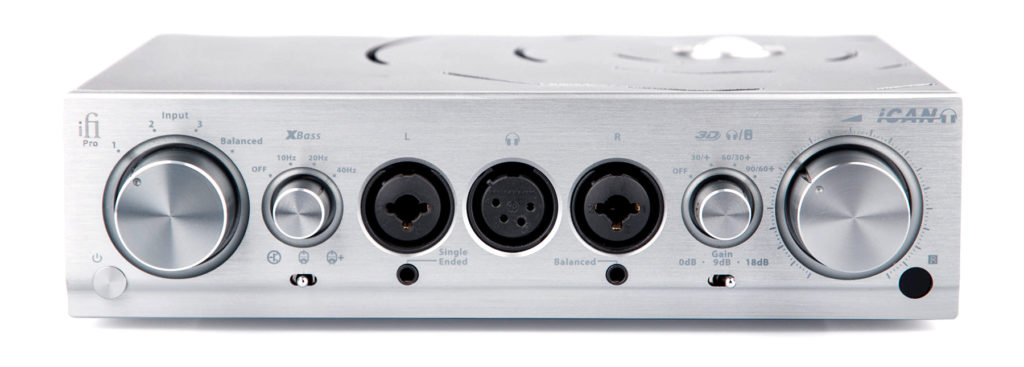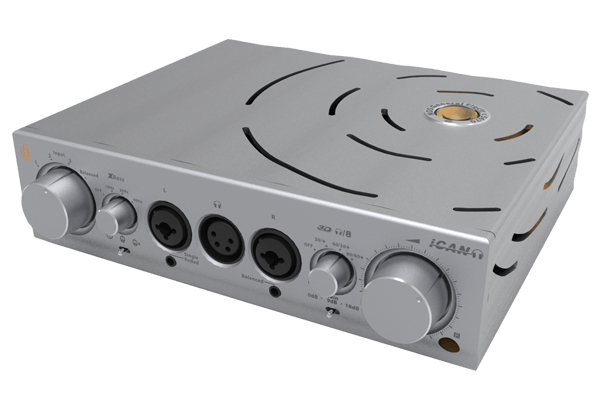
The iFi Pro iCAN headphone amplifier is iFi’s flagship headphone amplifier. The word flagship conjures up lofty expectations and sometimes astronomical prices. At $1,799, the Pro iCAN is not inexpensive, but it’s also not priced unreasonably high considering its laundry list of features. It’s designed to cover every possible thing you’d want to do with a pair of headphones, providing complete control over how you listen. A flagship product also represents a company’s finest engineering prowess, even aiming toward audio perfection.
I spent several months exploring every facet and detail of the iCAN’s performance and features, powering various headphones. How does it fare in real-world use? Are its audio-tweaking features a marketing gimmick or something that brings true value to your listening experience? Read on to find out how close it comes to audio bliss.
Features and Build Quality
Mirroring its symmetrical front panel layout, the internal circuit is a true differential balanced design. From the balanced XLR input to the balanced XLR output, this amplifier is a fully balanced “dual mono” design. It features a 6-way motorized volume potentiometer, custom manufactured to iFi’s specifications by ALPS in Japan. It uses four tracks to adjust the volume of the balanced signal. The other two monitor the volume control’s operation. This important design consideration ensures that the signal path stays fully balanced, with no loss of fidelity due to the implementation of the volume control.
Rounding out the above-average build quality are TDK Japan-made capacitors, Vishay thin film resistors, and ELNA Silmic II capacitors in the power supply. Metal casework and large control knobs give a feeling of robust, rock-solid reliability. Nothing you interact with on the iCAN feels cheap or plasticky.
With five different headphone jacks, the iCAN is ready for anything. iFi has also included two different ways to manipulate the sound to your liking. The first is a three-position XBass knob, and the second is the 3D knob, also with three specific settings. I’ll dive further into these features and their effects later.
There’s also a substantial amount of power on tap, up to 14wpc! This certainly sounds like an overkill for a headphone amplifier. However, ask anyone who’s paired up a high-wattage amplifier with a pair of speakers, and they’ll tell you there’s no such thing as too much power! The same concept applies here with headphone listening. Having a generous amount of clean power on tap offers big sonic advantages.
Sound and Performance

The first thing I heard from the iCAN was nothing at all. When I turned up the volume with no signal present, there was simply silence. This silent background is thanks to the external iPower Plus power supply, which features active noise cancellation. Sometimes I groan when I see an external brick-type power supply instead of an internal one. However, in this case, this is not simply a cheap switching power supply included as an afterthought. It’s been carefully designed to switch at a frequency that does not interfere with audio to keep the noise floor as low as possible.
The second thing I noticed is that there was seemingly limitless power available. It could reach astounding volume levels without any sort of audible distortion or breakup. I never needed to switch from the 0db gain setting on the front panel. However, it’s nice to know for extremely difficult-to-drive headphones, the 9db and 18db options are there.
Lastly, I noticed above-average resolution, clarity, and rhythmic drive. The overall sound signature was neutral and confident, allowing your favorite music to speak for itself. Using the balanced input with my Benchmark DAC3 B resulted in slightly more impactful bass, and somewhat more dynamic and expansive highs. The difference between the balanced and single-ended inputs is subtle, however, I recommend you use the balanced input to take full advantage of the iCAN’s fully balanced signal path.
The iCAN is a pure Class A design, so it does tend to run hot. I stress-tested it on several consecutive 95-degree summer days. Despite the enclosure getting hot to the touch, there were no reliability issues or faults. Torture tests passed, the music never stopped flowing!
Tube vs. Solid State

The iCAN has both solid-state and tube output modes. They are two discrete circuits, meaning they have no sonic impact on each other. This seems obvious, but ultimately it’s a crucial design consideration. It ensures that you won’t degrade or hamper your listening experience by having the choice of two operational modes. These aren’t simple EQ algorithms or DSP effects. You’ll hear the actual physical changes by switching between solid-state JFET transistor output and the NOS General Electric 5670 tubes.
Engaging the tube mode may not be as dramatic of a change as you are expecting. In fact, it does not apply rose-colored glasses to your music. Nor does it make it sound sweet and romantic with an overly warm midrange. Instead, the effect is subtle, and it was hard to differentiate between the solid-state and tube modes.
Switching to tube+ mode is more noticeable yet still relatively minor. It adds a more apparent coloration to the sound by reducing negative feedback to a minimum. This results in a greater amount of the tube’s natural harmonics being produced. It sounded like the leading-edge transients became a tad softer, and the overall feel of the music was more blended and harmonized.
As a detail lover, I enjoy hearing every single sound possible, so I did most of my listening in solid-state mode.
Covering All the Bases
To evaluate the versatility of the iCAN, I used it with a variety of headphones. I used aftermarket 4-pin balanced cables with the Sennheiser and Audeze headphones, as there was a noticeable improvement in clarity over the ¼” TRS jack.
Sennheiser HD600
Despite being one of the most popular entry-level audiophile headphones, I couldn’t stand the sound of the HD600s until I tried them through the iCAN. The iCAN transforms them into being listenable and even enjoyable thanks to the 20Hz XBass setting. The XBass knob is the best implementation of a bass boost EQ I’ve ever heard. It precisely wakes up the bottom end of the HD600s and balances out the high frequencies. Thanks to the iCAN’s copious amount of clean power, they can easily handle the additional bass energy.
The Sennheisers are my new go-to pairing for long listening sessions. They’re fast, dynamic, airy, and articulate. The iCAN and HD600 pairing make these headphones sound better than their $300 price would indicate. It’s a great example of how a high-quality amplifier makes ordinary headphones sound extraordinary.
Audeze LCD-3
The iCAN successfully delivered the impressive spaciousness and dimensionality I expect from these premium headphones. The generous power on tap provided an appropriate and balanced amount of low-end fill. This pairing excelled with jazz and acoustic guitar, especially when I set the 3D knob to the 30-degree angle. This shifted the soundstage of Paul Desmond’s Bossa Antigua just slightly out and around toward the front, putting me right in the middle of the performance.
When I listened to Ike Quebec’s Soul Samba album, switching the 3D knob to the 60-degree angle setting was dramatic. I looked down at the speakers sitting on my desk because it sounded like the music came from them instead of the headphones I was wearing.
Switching to electronic music, the visceral textures inside Operon’s Peace Be Unto You washed over me. The synthesizer’s oscillating harmonies felt palpable. No coloration, great rhythm and momentum, and a completely black background allowed for enjoyable and introspective listening sessions.
Cardas A8 30th Anniversary
I tried these IEMs through both the 3.5mm iEMatch jack as well as the regular ¼” TRS jack. While the iEMatch feature did allow me a more useful range of volume adjustment, I felt it took away some of the liveliness of the treble energy. Instead, I preferred using the regular ¼” jack because it provided a more energetic sound. Fortunately, due to the high-quality volume potentiometer, there were no channel imbalance issues even at the lowest volume settings.
The A8s provided ample bass energy and fatigue-free treble frequencies. Even with these extremely sensitive and unforgiving IEMs, the iCAN sounded pristine and accurate.
Versatility and Control
The iCAN seems comfortable powering any headphone type, from low-impedance IEMs to open back planar magnetics and everything in-between. Its implementation of the XBass and 3D features are nearly flawless and demonstrate impressive engineering. They allowed me to quickly dial in the best sound for each song. The 3D setting is subtle and doesn’t take anything away from the original composition — it’s not gimmicky or overdone. These carefully implemented analog-based adjustments enhanced my listening experience.
The iCAN also doubles as a fully-featured preamp, which includes the front panel settings and adjustments. I tested this thoroughly with my powered desktop speakers, and it performed admirably. The 3D knob truly expanded the soundstage of my near-field desktop speakers. The preamp functionality adds to the already impressive versatility of the iCAN. iFi thought of every listening scenario when they were designing this product.
Conclusion and Value
The iFi Pro iCAN feels like a high-quality product that will provide many years of enjoyment past its warranty coverage period of, wait, ONE year? It surprised me that iFi only includes a 1-year warranty with the iCAN. iFi should seriously consider extending the warranty to either three or five years. It would show pride for iFi to stand behind its flagship headphone amplifier with a more generous warranty.
What about value? At $1,799, there are many headphone amplifiers to consider. The iFi Pro iCAN has unmatched versatility, providing something for every listener. It also has an immense amount of power on tap, never hardening up or sounding strained when I cranked up the volume. However, from a pure sound quality perspective, my SPL Phonitor X at $2,499 is more refined and dynamic. I would expect this for $700 more, but the iCAN does get remarkably close to the Phonitor’s performance level.
I thoroughly enjoyed my time listening with the iFi Pro iCAN, especially with the thoughtful and intuitive way the XBass and 3D knobs are implemented. It was effortless to dial in the perfect sound signature for every song with this level of control.
When this level of engineering is on display in a company’s flagship product, it’s exciting and makes me want to experience the other products in their lineup. Well done iFi! Your intricate and meticulous approach to designing the iCAN is not lost on me.


Thanks for this review, Drew, interesting and clear. Your comment about the great benefits of clean and powerful amplification is particularly important to make even lower priced speakers and headphone really “sing”.